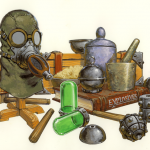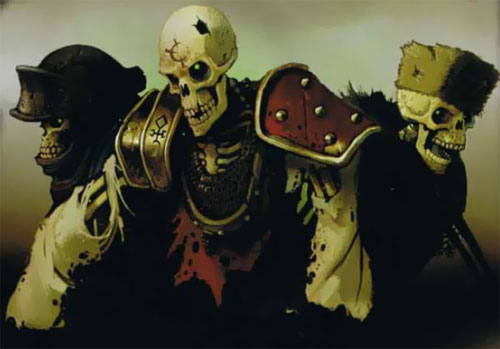The new Iron Kingdoms Roleplaying Game system has been out for a couple of weeks, so it’s high time we take a look at character creation options. A striking feature of the process is that each player character has two starting careers, and can pick up more as his adventuring life runs on. So which careers to pick? Some appear to compliment each other nicely, but with all your skill and ability choices limited by per-career lists, you run a serious risk of making somebody that’s totally worthless in a scrap or completely helpless outside a fight.
To help mitigate this, the following technique can be applied to each career you are considering. Plot out your careers on two axes, Urban vs. Wilderness and Combat vs. Skills. If your GM wants to run a combat-intensive urban campaign, you would be well-served to lean towards a career combination that suits. Such a character may be a boat-anchor in a wilderness skilled campaign.
The Procedure: Keep two running tallies, one for Urban, one for Combat. Add five to the Urban tally for every starting ability, connection, or skill that is clearly urban, subtract five for those that are clearly not. Many don’t fit neatly, so don’t apply any number for those. For abilities, connections, and skills available through advancement, add or subtract four for every ability or connection. The values are ten for any skill capped at four, five for any skill capped at three, one for any skill capped at two. Repeat for Combat but add five for each spell the career starts with (spellcasters are for killing stuff in this setting, mostly).
As and example, take the Alchemist’s Combat axis:
- +10 Combat for starting abilities
- +10 Combat for starting military skills.
- -10 Combat for starting occupational skills.
- +16 Combat for advancement abilities.
- -4 Combat for advancement connections.
- +12 Combat for advancement military skills.
- -61 Combat for advancement occupational skills.
- Total of -27 Combat. The Alchemist is mostly a skilled career.
Now for the Urban axis:
- +0 Urban for starting abilities.
- +5 Urban for starting skills.
- +4 Urban for advancement connections.
- +41 Urban for advancement skills
- Total of +50 Urban. There’s nothing inherently outdoorsy about being an Alchemist.
Contrast this with the Ranger:
- +10 Combat for starting abilities
- +10 Combat for starting military skills.
- -20 Combat for starting occupational skills.
- +36 Combat for advancement abilities
- +42 Combat for advancement military skills.
- -61 Combat for advancement occupational skills.
- -10 Urban for starting abilities.
- -10 Urban for starting skills.
- -32 Urban for advancement abilities.
- -39 Urban for advancement skills
- Total of 17 Combat. The Ranger has a lot of skills and a lot of fighting prowess
- Total of -91 Urban. This career is built for the wild places between cities.
Theoretically if you were to make a character that is an Alchemist/Ranger you add these scores together for a -10 Combat / -41 Urban character that is probably better suited for a wilderness campaign with a mix of fighting and skill play than for a combat-heavy urban campaign.
Of course, this is highly-generalized and a great deal of the point totals come from choices available to the character as he gains experience. An Alchemist/Ranger that keeps picking up skills from the Alchemist career has he advances is going to be much more urban, and depending on the abilities selected during advancement there’s a lot of room to become something of a walking calamity in combat.


